
Dichanthelium is genus of flowering plants of the grass family, Poaceae. They are known commonly as rosette grasses and panicgrasses.

Platystemon is a monotypic genus of flowering plants in the poppy family containing the single species Platystemon californicus, which is known by the common name creamcups. It is native to Oregon, California, Arizona, Utah and Baja California, and is found in open grasslands and sandy soils below 6,000 feet (1,800 m) elevation.
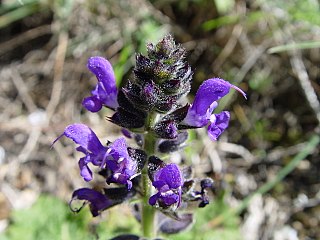
Salvia verbenaca, also known as wild clary or wild sage, is native to the British Isles, the Mediterranean region in Southern Europe, North Africa, and Near East, and in the Caucasus. It can be found as an introduced species that has naturalized in meadows in the Eastern United States.

Rhinotropis californica, synonym Polygala californica, is a species of flowering plant in the milkwort family known by the common name California milkwort. It is native to southwestern Oregon and northern and central California, where it grows in the coastal mountain ranges in local habitat types such as chaparral and forest. It is a perennial herb producing spreading stems, generally decumbent in form, up to about 35 centimeters in maximum length, lined with narrow oval leaves each a few centimeter long. The upper inflorescences produce several open flowers, and there may be some closed, cleistogamous flowers lower on the plant. The open flowers have pink or white winglike lateral sepals with hairy edges. The petals are similar in color, the central one tipped with a white or yellow beak. The fruit is a flattened green capsule up to a centimeter long containing hairy seeds.

Rhus aromatica, the fragrant sumac, is a deciduous shrub in the family Anacardiaceae native to North America. It is found in southern Canada and nearly all of the lower 48 states except peninsular Florida.
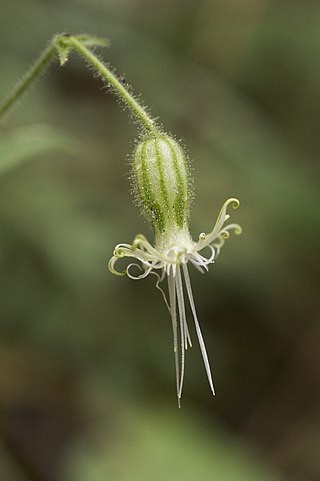
Silene lemmonii is a species of flowering plant in the family Caryophyllaceae known by the common name Lemmon's catchfly.

Clitoria fragrans is a rare species of flowering plant in the legume family known by the common name pigeon wings, or sweet-scented pigeon wings. It is endemic to Central Florida, where it was known most recently from 62 occurrences, but no current estimates of the total global population are available. The plant is a federally listed threatened species of the United States.

Polygala lewtonii is a rare species of flowering plant in the milkwort family known by the common name Lewton's polygala, or Lewton's milkwort. It is endemic to Florida in the United States, where it is limited to the central ridge of the peninsula. There are about 49 occurrences of the plant remaining. Most occurrences contain very few plants. The species is threatened by the loss and degradation of its habitat. This is a federally listed endangered species of the United States.
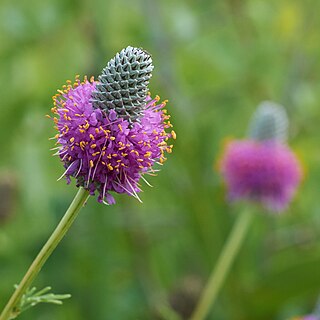
Dalea purpurea is a species of flowering plant in the legume family known as purple prairie clover. Native to central North America, purple prairie clover is a relatively common member of the Great Plains and prairie ecosystems. It blooms in the summer with dense spikes of bright purple flowers that attract many species of insects.

Calamagrostis montanensis is a species of grass known by the common names plains reedgrass and prairie reedgrass. It is native to North America, where it is found across Canada from British Columbia to Manitoba and south to Colorado in the United States.
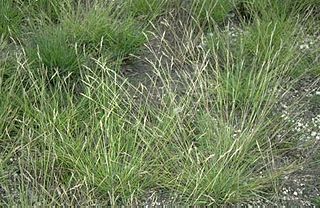
Danthonia spicata is a species of grass known by the common name poverty oatgrass, or simply poverty grass. It is native to North America, where it is widespread and common in many areas. The species is distributed across much of Canada and the United States, and its distribution extends into northern Mexico.
Actaea arizonica is a species of flowering plant in the buttercup family known by the common name Arizona bugbane. It is endemic to Arizona in the United States, where it occurs in Coconino, Gila, and Yavapai Counties. Like some other species in genus Actaea, this plant was formerly included in the genus Cimicifuga.

Amphicarpum muehlenbergianum is a species of grass known by the common names blue maidencane, Muhlenberg maidencane, and goobergrass. It is native to the southeastern United States.
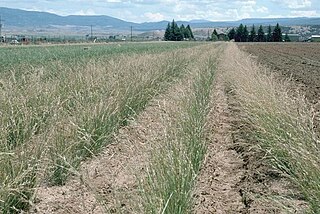
Bromus marginatus is a species of grass known by the common name mountain brome. It is native to western North America, and it is used widely for grazing animals and revegetating landscapes.
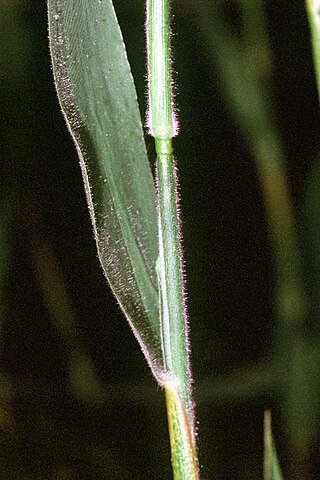
Dichanthelium scoparium is a species of grass known by the common names velvet panicum, velvety panicgrass, and broom panicgrass. It is native to North America, where it occurs in the southeastern United States. It also occurs in the West Indies.
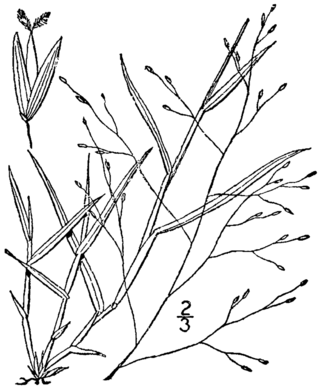
Digitaria cognata is a species of grass known by the common names fall witchgrass, Carolina crabgrass, and mountain hairgrass.

Panicum anceps is a species of grass known by the common name beaked panicgrass. It is native to the southeastern United States, where it occurs as far north as New Jersey and as far west as Kansas and Texas.

Paspalum floridanum is a species of grass known by the common name Florida paspalum. It is native to the eastern United States.

Eragrostis pilosa is a species of grass in the family Poaceae. It is native to Eurasia and Africa. It may or may not be native to North America. It is widely introduced, and it is a common weed in many areas.
Ruellia noctiflora, the nightflowering wild petunia, is a herbaceous perennial found along the Gulf coast. Both its specific and common names derive from its habit of nocturnal flowering. In spite of the common name it is in a different family from the garden petunia.



















